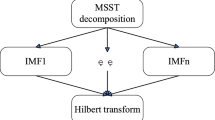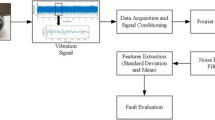Abstract
Fault signals measured from a damaged rolling bearing usually exhibit amplitude modulation (AM)-frequency modulation (FM) properties. For this kind of signal, the demodulation technique is an effective and common method. In the demodulation techniques, a variety of energy operator (EO) tools have been available due to high computational efficiency and self-adaptability to transient signals. Hence, an alternative energy measure is proposed in this work. The new demodulation technique is achieved by combining a multiresolution higher-order symmetric difference sequence with the envelope-derivative operator (EDO). The multiresolution higher-order symmetric envelope-derivative operator (MHOS-EDO) can extract the weak bearing fault characteristics in a harsh environment without any pre-filtering. Especially in the presence of vibration interferences, its unique energy transformation can eliminate the influence of vibration interferences, so that the vibration interferences will no longer appear in the energy spectrum. Through simulation and practical experiments, the superiority of MHOS-EDO in dealing with noise and interfering components is demonstrated. Meanwhile, the comparison results reveal that the MHOS-EDO outperforms some previous EO and some other bearing fault identification methods.
Similar content being viewed by others
References
G. Tang, X. Wang and Y. He, Diagnosis of compound faults of rolling bearings through adaptive maximum correlated kurtosis deconvolution, Journal of Mechanical Science and Technology, 30 (1) (2016) 43–54.
Z. He et al., Weak fault detection method of rolling bearing based on testing signal far away from fault source, Journal of Mechanical Science and Technology, 34 (2020) 1035–1048.
G.-Y. Lee et al., Machine health management in smart factory: a review, Journal of Mechanical Science and Technology, 32 (3) (2018) 987–1009.
P. Henríquez Rodríguez et al., Application of the Teager-Kaiser energy operator in bearing fault diagnosis, ISA Trans., 52 (2) (2013) 278–284.
S. Jin and S. K. Lee, Bearing fault detection utilizing group delay and the Hilbert-Huang transform, Journal of Mechanical Science and Technology, 31 (2017) 1089–1096.
D. Zhu et al., Adaptive combined HOEO based fault feature extraction method for rolling element bearing under variable speed condition, Journal of Mechanical Science and Technology, 32 (2018) 4589–4599.
A. C. Bovik, P. Maragos and T. F. Quatieri, AM-FM energy detection and separation in noise using multiband energy operators, IEEE Trans. Signal Process, 41 (12) (1993) 3245–3265.
P. K. Banerjee and N. B. Chakrabarti, Noise sensitivity of Teager-Kaiser energy operators and their ratios, 2015 Int. Conf. Adv. Comput. Commun. Informatics (2015) 2265–2271.
M. Liang and I. Soltani Bozchalooi, An energy operator approach to joint application of amplitude and frequency-demodulations for bearing fault detection, Mech. Syst. Signal Process, 24 (5) (2010) 1473–1494.
X. Jiang, S. Li and C. Cheng, A novel method for adaptive multiresonance bands detection based on VMD and using MTEO to enhance rolling element bearing fault diagnosis, Shock Vib., 2016 (2016) 8361289.
H. Faghidi and M. Liang, Bearing fault identification by higher order energy operator fusion: a non-resonance based approach, J. Sound Vib., 381 (2016) 83–100.
Y. Wang, L. Gu and Y. Xu, Enhancement of bearing fault detection using an alternative analytic energy operator and sparse Bayesian step-filtering, Journal of Mechanical Science and Technology, 35 (3) (2021) 905–920.
Y. Xu, F. Fan and X. Jiang, A fast iterative filtering decomposition and symmetric difference analytic energy operator for bearing fault extraction, ISA Trans., 108 (2021) 317–332.
D. Zhao et al., Vibration health monitoring of rolling bearings under variable speed conditions by novel demodulation technique, Struct. Control Heal. Monit., 28 (2) (2021) e2672.
Y. Wang, L. Gu and Y. Xu, Enhancement of bearing fault detection using an alternative analytic energy operator and sparse Bayesian step-filtering, Journal of Mechanical Science and Technology, 35 (3) (2021) 905–920.
J. M. O’Toole, A. Temko and N. Stevenson, Assessing instantaneous energy in the EEG: a non-negative, frequency-weighted energy operator, 2014 36th Annu. Int. Conf. IEEE Eng. Med. Biol. Soc. EMBC, 2 (3) (2014) 3288–3291.
Z. Cai, Y. Xu and Z. Duan, An alternative demodulation method using envelope-derivative operator for bearing fault diagnosis of the vibrating screen, Journal Vib. Control, 24 (15) (2018) 3249–3261.
Y. Imaouchen et al., A frequency-weighted energy operator and complementary ensemble empirical mode decomposition for bearing fault detection, Mech. Syst. Signal Process, 82 (2017) 103–116.
J. Fang and L. E. Atlas, Quadratic detectors for energy estimation, IEEE Trans. Signal Process, 43 (11) (1995) 2582–2594.
J. H. Choi, H. K. Jung and T. Kim, A new action potential detector using the MTEO and its effects on spike sorting systems at low signal-to-noise ratios, IEEE Trans. Biomed. Eng., 53 (4) (2006) 738–746.
J. H. Choi and T. Kim, Neural action potential detector using multi-resolution TEO, Electron. Lett., 38 (12) (2002) 541–543.
T. F. Quatieri, Energy separation in signal modulations with application to speech analysis, IEEE Trans. Signal Process, 41 (10) (1993) 3024–3051.
R. B. Randall and J. Antoni, Rolling element bearing diagnostics-a tutorial, Mech. Syst. Signal Process, 25 (2) (2011) 485–520.
B. Jiang, J. Pei and Y. Tao, Clustering uncertain data based on probability distribution similarity, IEEE Trans. Knowl. Data Eng., 25 (4) 751–763.
S. Zhang et al., Time-varying singular value decomposition for periodic transient identification in bearing fault diagnosis, J. Sound Vib., 379 (2016) 213–231.
Acknowledgments
This work was supported by the Natural Science Foundation of Shaanxi Province (No. 2020JM-249).
Author information
Authors and Affiliations
Corresponding author
Additional information
Wu Kun received a M.D. in Mechanical Engineering from the Xidian University, Xi’an, P. R. China, in 2013. Now he works at the Department of Mechanical and Electrical Technology, Xijing University, Xi’an, P. R. China. His current research interests include rotating-machine fault diagnosis and signal analysis and processing, et al.
Rights and permissions
About this article
Cite this article
Wu, K., Xu, Y., Yang, N. et al. A multiresolution higher-order symmetric envelope-derivative operator and its application to bearing fault detection. J Mech Sci Technol 37, 1165–1175 (2023). https://doi.org/10.1007/s12206-023-0203-5
Received:
Revised:
Accepted:
Published:
Issue Date:
DOI: https://doi.org/10.1007/s12206-023-0203-5




